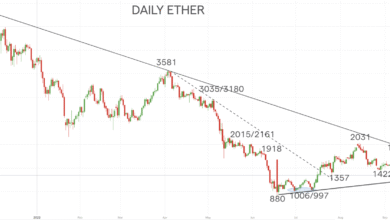Digital Ruble: What to Expect from Its Upcoming Rollout

The digital ruble is poised to revolutionize the Russian financial landscape as the country embraces the concept of central bank digital currencies (CBDCs). Recently, the State Duma has approved a crucial bill that lays the groundwork for the digital ruble rollout, introducing a universal QR code to streamline digital currency transactions. This innovative payment system aims to enhance efficiency for banks and retailers while ensuring consumers can easily access and use this new digital currency. With a three-year window for implementation, the digital ruble is set to be integrated into everyday transactions, promoting a cashless economy in Russia. As discussions around the digital ruble continue, its potential impact on the financial ecosystem becomes increasingly significant, marking a pivotal shift in how Russians handle their finances.
As the world witnesses the rise of digital payments, Russia is gearing up to introduce a universal digital currency, often referred to as the digital ruble. This pioneering initiative is part of the broader movement towards central bank digital currencies (CBDCs) globally, aimed at modernizing payment systems. The forthcoming legislation from the State Duma not only focuses on facilitating digital transactions but also highlights the introduction of a universal payment code that will bridge the gap between traditional banking and digital currency. By adopting this cutting-edge approach, Russia seeks to enhance transparency and efficiency in financial operations. The anticipated benefits of this digital transformation are expected to reshape the fiscal landscape and redefine the consumer experience in the near future.
Understanding the Digital Ruble and Its Significance
The digital ruble represents a significant evolution in the way that currency operates within Russia and the broader global financial landscape. As a central bank digital currency (CBDC), the digital ruble aims to modernize the payment systems and provide a state-backed alternative to traditional cash and cryptocurrencies. This move reflects a global trend where various nations, including Russia, are investing in digital currencies to enhance transaction efficiency and security. The digital ruble rollout is expected to foster a more inclusive financial ecosystem, where citizens can access digital financial services more conveniently.
In addition to facilitating transactions, the digital ruble aims to improve the economy’s transparency and efficiency. By introducing a universal QR code system, which is expected to be integrated into both banking and retail frameworks, the digital ruble could significantly enhance the speed and safety of payments. This universal code will streamline the process of making and receiving payments, thereby making digital transactions easier for everyday consumers. The State Duma’s approval of the bill marks a pivotal step toward realizing these benefits, as it showcases the government’s commitment to embracing digital transformation in the financial sector.
The Bill for Digital Ruble Massification and Its Implications
The digital ruble payments bill, currently under review by the Russian State Duma, outlines a three-year timeline for banks and retail outlets to fully integrate a universal QR code. This legislative action signifies a robust step toward actioning the vision of widespread digital currency use in Russia. As countries worldwide are observing the emergence of CBDCs, this bill underscores the importance of adapting to the changing financial landscape to remain competitive. By establishing a conventional medium of exchange within the framework of digital currency, Russia aims to improve economic interactions and maintain oversight over digital transactions.
More importantly, the bill also emphasizes the necessity for technology providers and payment operators to collaborate in refining the digital ruble infrastructure. Starting from January 1, 2026, a universal payment code will be mandated for money transfers, enhancing transaction transparency and user experience. Analysts suggest that while the State Duma advocates for rapid progression, some sectors may require an extension to 2027 due to technical constraints. This showcases the balancing act the Russian government must navigate between innovation and practical implementation, ensuring that the digital ruble serves the intended economic function without causing disruption.
Challenges and Opportunities in Digital Ruble Rollout
The anticipated rollout of the digital ruble brings both opportunities and challenges to the Russian financial sector. On one hand, the introduction of the digital ruble and accompanying infrastructure like the universal QR code can reinforce economic transparency and efficiency. It allows consumers and businesses to transact with greater ease and fosters an environment conducive to cashless payments. As the adoption of digital currencies grows globally, Russia aims to position itself as a leader in this emerging ecosystem through the strategic rollout of the digital ruble.
Conversely, the implementation of the digital ruble does not come without potential obstacles. Concerns surrounding cybersecurity, data privacy, and the need for robust technological frameworks are paramount. Financial institutions must develop the necessary systems to handle digital ruble transactions while safeguarding against fraud and ensuring data integrity. Moreover, consumer acceptance is crucial; engaging with the public to promote understanding and confidence in the digital ruble will play a central role in its eventual success. As the State Duma continues to discuss and refine the bill, addressing these challenges will be essential for a successful launch.
The Role of Central Bank Digital Currencies Globally
As the world continues to embrace digital technology, central bank digital currencies (CBDCs) have emerged as a prominent solution to modernize financial systems. Across the globe, nations are exploring the advantages of adopting CBDCs, recognizing their potential to improve payment speed, lower transaction costs, and enhance financial inclusion. This global trend is not only reshaping consumer behaviors but also transforming how monetary policy is conducted, paving the way for more effective economic regulation while providing states with enhanced control over their national currencies.
In Russia, the digital ruble is part of this broader movement towards CBDCs. By aligning its monetary policies with the global push for digital currencies, the Russian government desires to ensure that its economy remains competitive. The digital ruble’s rollout will likely bolster domestic markets while allowing for seamless international transactions. As countries refine their CBDC frameworks, a collaborative approach may emerge, where nations can share insights and learn from one another’s experiences in implementing digital rubles and currencies.
Future Prospects for the Digital Ruble and the Russian Economy
Looking ahead, the potential impact of the digital ruble on the Russian economy is significant. With the State Duma’s approval of the digital ruble payments bill, the groundwork is laid for a future where digital transactions become ubiquitous. The financial landscape may shift fundamentally as businesses and consumers adapt to these changes, fostering a new era of economic efficiency. Key industries, such as retail and services, may find that embracing digital ruble payments allows them to operate more effectively, reducing costs and improving customer experiences.
Furthermore, the state’s preparation to utilize digital ruble payments for budget allocations highlights its anticipated role in enhancing transparency in public finance. By streamlining the flow of budgetary payments through a digital currency, the government could significantly increase accountability and reduce instances of corruption. The overarching aim is to create a more robust economic framework that encourages trust and stability within the Russian financial system. As the rollout progresses, monitoring the reception and efficacy of the digital ruble will provide insights into its long-term viability and influence on Russia’s economy.
Public Sentiment and Acceptance of the Digital Ruble
Public sentiment plays a crucial role in the adoption of the digital ruble in Russia. As the government moves to implement this new form of currency, listening to public opinions and concerns will be essential for its success. There might be skepticism among citizens regarding privacy, security, and the implications of a fully digital currency for their everyday transactions. Addressing these concerns transparently through awareness campaigns and information dissemination can foster trust in the digital ruble.
Moreover, engaging with various stakeholders, including businesses and consumers, can bridge the gap between skepticism and acceptance. Collecting feedback on the usability of the digital ruble system, educating users on how to transact securely, and highlighting the benefits of a centralized digital currency are critical strategies. As public understanding of the digital ruble improves, so will its adoption, facilitating a smoother transition toward a cashless economy.
Technical Considerations for the Digital Ruble Implementation
Implementing the digital ruble requires robust technological frameworks that may challenge existing banking institutions in Russia. It is imperative to develop secure digital infrastructure tailored to handle the unique complexities of a digital currency. This includes creating secure systems for data storage and transaction processing to prevent cyber risks and ensure privacy protection for users. The State Duma’s timeline for the adoption of the universal QR code provides a vital pathway towards establishing this infrastructure, but it requires collaboration between various players in the financial ecosystem.
Additionally, financial institutions must invest in training and development to prepare personnel for managing digital currency transactions effectively. The technical challenges posed by the digital ruble entail equipping banks and payment processors with the necessary tools to navigate the transition smoothly. Effective implementation hinges on a comprehensive strategy that encompasses technology integration, staff training, and consumer education to ensure all stakeholders are adequately prepared for the shift to a digital currency.
Legislative Framework Supporting the Digital Ruble
The legislative framework surrounding the digital ruble is designed to create a solid foundation for its introduction into the financial landscape of Russia. By setting out clear rules and provisions through the digital ruble payments bill, the State Duma is establishing guidelines to govern the use of this central bank digital currency (CBDC). This regulatory framework serves to protect the interests of consumers and businesses alike, ensuring that the digital ruble operates in a safe and secure environment.
Furthermore, the legislation also considers the integration of various players in the payment ecosystem, including private financial institutions and technology providers. Collaborative frameworks foster accountability and support the overall goals of digital currency implementation. As the law evolves through the legislative process, it may also adapt to address emerging challenges in the digital economy, highlighting the dynamic nature of regulatory oversight in the face of rapid technological advancement.
Conclusion: The Future of Digital Currency in Russia
As Russia moves toward the realization of the digital ruble, its potential impact reverberates through the broader landscape of digital currency. The government’s commitment to establishing a clear regulatory framework alongside technological development is essential for timely and effective implementation. By addressing public concerns and embracing collaborative efforts, Russia can pave the way for an innovative financial future that aligns with global trends in digital currencies.
In conclusion, the successful rollout of the digital ruble has the power to transform the Russian economy and enhance financial efficiency. Maintaining transparency and fostering trust will be crucial, as will the continued evaluation of user experience and engagement. As Russia joins the ranks of countries exploring CBDCs, the lessons learned from this journey can provide valuable insights for other nations poised to follow suit.
Frequently Asked Questions
What is the digital ruble and how does it function as a digital currency?
The digital ruble is Russia’s central bank digital currency (CBDC), designed to operate alongside traditional rubles in digital formats. It aims to facilitate ease of payment and transactions within the Russian economy, offering a secure and efficient method for digital currency exchanges.
How will the digital ruble rollout impact Russian banks and retailers?
The digital ruble rollout, supported by a recently approved bill in the State Duma, requires Russian banks and retailers to adopt a universal QR code for transactions. This implementation, expected to take place over three years, aims to improve payment processes and enhance customer experiences with digital currency.
What are the benefits of using a universal QR code with the digital ruble?
The universal QR code will simplify transactions involving the digital ruble by providing a standardized method for payment processing. This efficiency is anticipated to enhance user experience, minimize transaction times, and support the widespread adoption of digital currency among consumers and businesses.
When is the expected launch date for the digital ruble in Russia?
The digital ruble is projected to launch for general use in 2024, following legislative discussions in the State Duma that outline the timeline for implementation and requirements for banks and retailers to adapt their systems for this new digital currency.
What authority oversees the digital ruble’s introduction in Russia?
The introduction of the digital ruble is overseen by the Central Bank of Russia, which is responsible for the development and regulation of the digital currency, ensuring that it aligns with national financial policies and enhances the overall payment system.
What challenges may affect the adoption of the digital ruble in Russia?
Several challenges could impact the adoption of the digital ruble, including technical difficulties faced by institutions and concerns about consumer acceptance. Analysts suggest that addressing these issues may require additional time, potentially delaying the rollout until 2027 for a more effective implementation.
How will the digital ruble enhance transparency in budget allocations?
The digital ruble is expected to improve transparency in budget allocations by providing a clear and traceable method for public funds disbursement. This development aims to enhance accountability and visibility in governmental financial transactions, benefiting both citizens and public officials.
Will the digital ruble be mandatory for all transactions in Russia?
While the digital ruble is expected to be widely adopted following its rollout, there is ongoing debate about the necessity of mandatory acceptance. The Russian government is facilitating this transition but recognizes the need for voluntary adjustment among businesses and consumers.
How does the State Duma play a role in the digital ruble development?
The State Duma, as Russia’s lower house of parliament, plays a crucial role in the development of the digital ruble through legislative discussions and approvals of bills that set the framework for its implementation and the operational guidelines for banks and retailers.
What implications does the digital ruble have for future monetary policies in Russia?
The introduction of the digital ruble is likely to influence future monetary policies by providing new tools for the Central Bank of Russia, enhancing financial stability, and increasing the effectiveness of policy measures aimed at managing inflation and economic growth.
| Key Points | Details |
|---|---|
| Digital Ruble Payments Bill | The bill has been approved for its first reading by the State Duma. |
| Universal QR Code Implementation | A universal QR code will ease payments using the digital ruble, with a three-year implementation period for banks and retailers. |
| Launch Timeline | Further preparations are underway for a digital ruble launch, expected by 2024. |
| Postponement Reasons | The rollout was originally planned for this year but was postponed to 2027 due to technical challenges. |
| Public Sector Inclusion | The digital ruble will be used for budget allocations, promoting transparency in public funds. |
Summary
The digital ruble is set to become a significant addition to Russia’s payment landscape as the country prepares for the rollout of its central bank digital currency (CBDC). Recently, the State Duma approved the first reading of a bill that introduces a universal QR code, which will simplify transactions for both banks and retailers. This initiative indicates a pivotal shift towards modernizing the Russian payment system and enhancing financial transparency. Although the official launch is tentatively scheduled for next year, technical hurdles may push this date further. Nevertheless, with plans to incorporate digital ruble payments for government allocations, the push for the digital ruble aims to create a more efficient and transparent financial environment.




